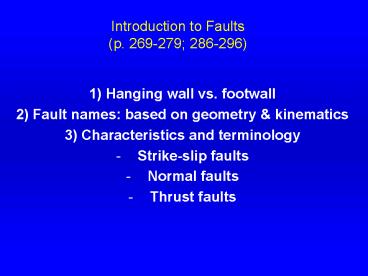Introduction to Faults PowerPoint PPT Presentation
1 / 25
Title: Introduction to Faults
1
Introduction to Faults (p. 269-279 286-296)
- 1) Hanging wall vs. footwall
- 2) Fault names based on geometry kinematics
- 3) Characteristics and terminology
- Strike-slip faults
- Normal faults
- Thrust faults
2
Fault Fractures along which there is visible
offset by shear displacement generally planar or
curviplanar
3
Strike-slip faults Accommodate horizontal slip
between adjacent blocks
left lateral (sinistral)
right lateral (dextral)
left lateral vs. right lateral sense-of-slip
relative to a chosen block
4
What is it? left lateral vs. right lateral
Las Vegas shear zone
5
What is it?
6
What is it? (interpretation) left-lateral
strike-slip fault
7
Hanging wall The block toward which the fault
dips. Footwall The block on the underside of
the fault.
8
Normal fault hanging wall moves down with
respect to footwall
9
Normal faults generally place younger and/or
lower-grade rocks (in HW) on top of older and/or
higher-grade rocks (in FW)
10
Normal faults generally place younger and/or
lower-grade rocks (in HW) on top of older and/or
higher-grade rocks (in FW)
11
Thrust fault (reverse fault) hanging wall moves
upward relative to footwall
HW
FW
12
Thrust faults generally place older and/or
higher-grade rocks (in HW) on top of younger
and/or lower-grade rocks (in FW)
13
Thrust faults generally place older and/or
higher-grade rocks (in HW) on top of younger
and/or lower-grade rocks (in FW)
14
Thrust faults generally place older and/or
higher-grade rocks (in HW) on top of younger
and/or lower-grade rocks (in FW)
15
- Normal faults accommodate lengthening
16
- Thrust faults accommodate shortening
17
http//earth.leeds.ac.uk/learnstructure/index.htm
18
Slip vs. Separation Slip actual relative
displacement Separation apparent relative
displacement
19
A real example of apparent separation vs. true
slip!
20
- The key to describing slip along a fault lies in
measuring - (1) Direction of displacement
- (2) Sense of displacement
- (3) Magnitude of displacement
21
Listric curved faults that flatten with depth
22
Fault scarp results when a fault displaces the
ground surface
23
- Map Symbols a start
- Strike-slip fault
- Normal fault
- Thrust fault
- Fault dip and slip vector
24
Next lecture Intro to folds Read pp. 372-413
25
- Important terminology/concepts
- Faults- how are they defined?
- Hanging wall
- Footwall
- Strike-slip fault left-lateral (sinistral) vs.
right-lateral (dextral) - Normal faults younger/lower grade on
older/higher grade - Lengthening
- Thrust faults older/higher grade on
younger/lower grade - Shortening
- Slip vs. Separation?
- Drag fold
- Listric
- Fault scarp

